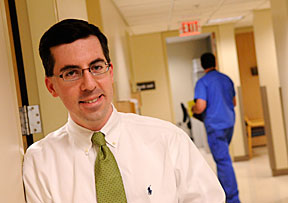Sweating is an essential function of the human body. We need the release of the salty liquid from the body's sweat glands to keep us cool when our body temperatures rise. Because sweating is the body's natural way of regulating temperature, we sweat more when it's hot outside. We also sweat more when we exercise or in response to situations that make us nervous, angry, embarrassed or afraid.
 |
| For some, sweating occurs regardless of excessive heat or exercise. These people suffer from hyperhidrosis, or excessive sweating. Douglas Minnich is a hyperhidrosis expert whose patients usually already have exhausted all medical treatment options and are exploring surgical treatments. |
This condition is known as hyperhidrosis, or excessive sweating, and it affects an estimated 1 percent of the nation's population, says Douglas Minnich, M.D., assistant professor of surgery and hyperhidrosis expert.
"There are probably many people who don't recognize that this is a specific disease or that there are treatment options for it," Minnich says. "Instead they just choose to deal with it, and it can have a negative impact on their lives. There are treatments available that can help with the condition."
Medical treatments include antiperspirant medications, botox injections in the hands and iontophoresis, a technique where patients are given a small electrical charge through their hands as they soak them in water.
By the time Minnich sees a patient with hyperhidrosis they have exhausted all medical treatment options and are exploring surgical treatment.
UAB thoracic specialists perform most of the region's surgeries for hyperhidrosis. The operation, known as a thoracoscopic sympathectomy, is a minimally invasive technique where the surgeon makes a one-centimeter incision below each armpit, enabling him to divide a portion of the sympathetic nerve - the nerve that affects sweating - inside the chest.
The operation is designed to help those who have excessive sweating of the hands, armpits and excessive craniofacial sweating.
"For those people whom medical treatments fail and the hyperhidrosis is primarily affecting the hands to the point that it's impacting other areas of their life, the operation is a nice alternative," Minnich says.
Excessive sweating of the hands can affect people in many ways, he says.
Many withdraw socially because they don't want to shake anyone's hand. One woman who sought treatment from Minnich said her hands would become so sweaty she did not want to pick up her new grandchild because she was afraid she would drop him. A young man soon to enter fire-fighter school came to Minnich recently because he was worried the excessive sweating in his hands would affect his ability to handle hoses and other tools.
One of the remarkable characteristics of hyperhidrosis is that the sweating can occur with no physical activity and regardless of temperature.
"I see people in the clinic who are just sitting there with me, and when they hold their arms out with their hands turned up, the sweat will start to run off kind of like a faucet dripping," Minnich says.
An operation is 90 percent effective in relieving the sweating in the hands, Minnich says. The efficacy goes down to approximately 70 percent for those who experience excessive sweating of the armpits. It is an outpatient procedure, and recovery time typically is two to three days.
Researchers aren't sure what causes hyperhidrosis, but it is thought to be a type of dysregulation in the autonomic nervous system.
The concept of dividing the sympathetic nerve to relieve the condition has been around for nearly 40 years, but it used to be done with a thoracotomy to open the chest and spreading the ribs to reach the nerve.
"Obviously many people looked at it and decided since it wasn't a life-threatening problem, they weren't going to voluntarily undergo such an invasive procedure with a huge incision," Minnich says. "They'd rather deal with the sweaty palms. But in the past 10 to 15 years, we started developing the technologies of video assisted thoracic surgery (VATS). That enables us to make the small incision, put a camera in the chest and perform the operation that way. This surgery is the perfect fit for that type of technology."
Historically, approximately 50 percent of patients who undergo surgery experience compensatory sweating after the procedure, typically on the back, thighs or legs. Still, Minnich says many patients still opt for the surgery if hand and underarm sweating interfere with their lifestyle.
Minnich also doesn't want misinformation about the surgery on the Internet to cloud anyone's judgment on the procedure. He says there are testimonials where people indicate they wish they had never had the surgery because they are now sweating much more in other places.
"I think most of those people probably had the operation, and it wasn't their hands and armpits that were bothering them," Minnich says. "I always stress to people in clinic that if it's the hands that are bothering you the most, then you are likely to be pleased with the results of the surgery; if you have some extra sweating on your back after the surgery, you can take that because your hands are drier. Unfortunately, some people that would be a good candidate for the surgery will read some of those things on the Internet and dismiss it. At least come in and hear it from someone who performs the surgery and get an opinion. I'm not here to talk a patient into or out of anything; I'm here to give patients information and help them make a decision."
Minnich says non-operative treatments should be tried first before considering surgery. Most insurance companies cover pre-operative treatments and an operation, if necessary. Contact your primary-care physician or contact Minnich at dminnich@uab.edu or 996-9879 for more information.